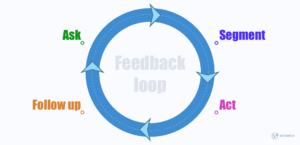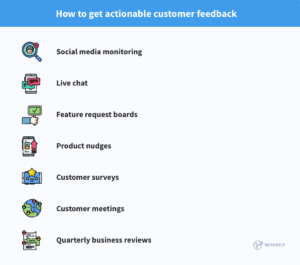
To genuinely understand customers and increase retention, businesses need to focus a big part of their resources and manpower on customer feedback. The way someone approaches feedback can make or break their business.
In this guide, we’ll show you just how valuable customer feedback can be and give some actionable tips on how to collect and act on it.
How Important Is Customer Feedback?
Feedback represents your customers’ positive experiences, frustrations, and pain points. It reveals why some clients love your brand and what’s preventing others from doing so. Basically, customer feedback allows looking into a customer’s perception of your brand and encourages targeted actions meant to increase customer satisfaction.
Considering all that, it’s safe to say that focusing on customer feedback and making business decisions based on it can bring in several advantages, including the following:
Help You Improve Your Product and Services
Customer feedback tells you exactly what changes to make to ensure existing customers continue doing business with you. For instance, feedback on customer services can let you know if your support team requires additional training, more manpower, or other resources to meet customer demands.
Product feedback can alert you to issues ruining the customer experience or feature requests that can boost it.
Marketing feedback can let you know if your copy is too aggressive, vague, or incorrect (like marketing text accidentally claiming your service can be integrated with a specific 3rd party service when it actually can’t).
Boost Referrals
Satisfied customers are more likely to tell others about your business – it’s as simple as that. Statistics show that happy customers tell up to nine people on average about their positive experiences with a company.
Moreover, according to data, 90% of consumers check online reviews before doing business with a company. What’s more, around 88% of them trust online reviews as much as personal recommendations.
Improve Customer Loyalty
The happier customers are with your brand, the more likely they are to stick around. According to research, about 74% of B2B buyers are willing to spend more money to continue doing business with a company that offers great service. What a customer defines as excellent customer service can range from great and prompt support to UI tweaks that streamline the customer experience.
Drive More Profit
Considering the above, this is pretty obvious. With loyal customers, retention is skyrocketing, referrals are driving more leads and your company is streamingly growing.
Besides that, research shows that highly-engaged customers will make purchases 90% more frequently and spend 60% more money per transaction.
What Is the Customer Feedback Loop?
In short, it’s a customer relationship management strategy that involves the collection and implementation of customer feedback. It’s often called the ACAF loop due to its four stages:
- Asking customers for feedback.
- Categorizing the received feedback.
- Acting on the feedback (sharing it with relevant departments, fixing bugs, etc.).
- Following up with customers to let them know about the improvements.

So, overall, the customer feedback loop is a continuous cycle in which you gather feedback, analyze, act, and follow up on it.
Acting on the feedback by implementing solutions ASAP, acknowledging how important customers’ suggestions were, and responding to clients to let them know reported issues were fixed are great ways to close the feedback loop. Doing that significantly boosts the customer experience since it shows how committed the business is to understanding their pain points and helping them achieve the desired results.
Plus, there’s a chance that not doing the above could potentially cause some clients to think their feedback isn’t taken seriously. So, a closed-loop system can put their concerns to rest, likely boosting satisfaction and loyalty rates.
How to Get Actionable Customer Feedback
Here are the six most efficient customer feedback methods – the ones that allow you to gather actionable data.

Before we start, though, here’s one thing you should keep in mind – customer feedback has to be collected and segmented for every step of the customer journey. You can’t get useful insights if you don’t do that.
Now, let’s dive into the most actionable methods and learn how to get the most out of them.
1. Monitor Social Media
When customers want to complain about a problem, mention bugs or glitches, or praise a brand, they don’t always reach out directly to the company. Instead, they’ll often post about it on social media, expecting your business to address their feedback. Right now, it seems that around 54% of people prefer to do that. And solving their complaints that way won’t just improve your image. It will also save you money since it’s six times less expensive to solve a customer issue on social media than through a call center, for instance.
Of course, keeping track of social media mentions on all relevant platforms isn’t really possible. Even if you have a whole team handling it, it would still take too much time and effort – resources that could be better spent on a different area of your business. Sure, some people might send you direct messages on social media, making things a bit easier, but not all customers will do that. Some of them will just talk about you in comments or posts where they won’t tag or link to your business.
Luckily, you can use social media monitoring tools that alert you whenever your brand is mentioned on various social media websites. Mention, Brand24, and Youscan are pretty decent options that help you quickly identify online mentions of your brand. Having your team use those tools to monitor social media feedback will be much more efficient. Just make sure they focus on the following things when analyzing social media comments and posts:
- The customer’s sentiment (positive, neutral, or negative).
- The main issues and themes recurring across most comments.
- The voice tone that was used (satisfied, frustrated, sarcastic, angry, etc.).
That way, relevant feedback can be collected and acted on in due time.
2. Create Feature Request Boards
As the name implies, a feature request board is an online board where customer requests are posted, stored, and analyzed by the product development team. You can either ask customers directly what new features and improvements they’d like to see or give them access to the board so they can post their suggestions or vote on existing ones.
There are plenty of reasons to use feature request boards:
- It makes your customers feel like their voices are actually heard and that they’re actively contributing to your product roadmap.
- It eliminates much of the guesswork involved in product development since you know exactly what your high-intent clients want the most.
- Your customers might feel a stronger bond with your brand, which could improve their loyalty.
- You’ll have an easy-to-use channel through which you can make users feel more appreciated by letting them know when you will implement their suggestions.
As for how you can do this, there are plenty of options. If you have the time and manpower, you can create a private Facebook group where customers can post their suggestions. Though, something like that only works well if you have many active and engaged customers. If you don’t, getting them to interact can be a bit difficult.
An easier way to collect data for the product roadmap is using a product like Canny – a user-friendly platform for collecting and organizing feature requests.
Alternatively, you can use other services to create feature request boards and gather customer feedback:
3. Use Customer Feedback Surveys
A customer survey is a great way to collect relevant data (referral potential, satisfaction rates, trust levels, etc.) from your audience. Customer feedback forms can be used too, but they are not as versatile as surveys. Plus, they tend to be longer, so clients may not be as inclined to spend their time filling them out.
Collecting feedback with surveys is pretty simple since they can be sent through emails, as in-app surveys, or through messaging platforms like Intercom. As for what types of surveys you can use, here are your options:
NPS (Net Promoter Score)
NPS is a type of survey that lets you track growth indicators which show how loyal your customers are, how likely they are to refer your brand to others, and how happy they are with your products and services. NPS customer feedback survey questions usually go something like this:
“How likely are you to recommend our business to a friend or work colleague?”
NPS surveys feature just one question, but they also use follow-up questions (one follow-up question is the general rule). Also, NPS scores can vary between -100 and 100, and responses are measured on a scale from 0 to 10.



